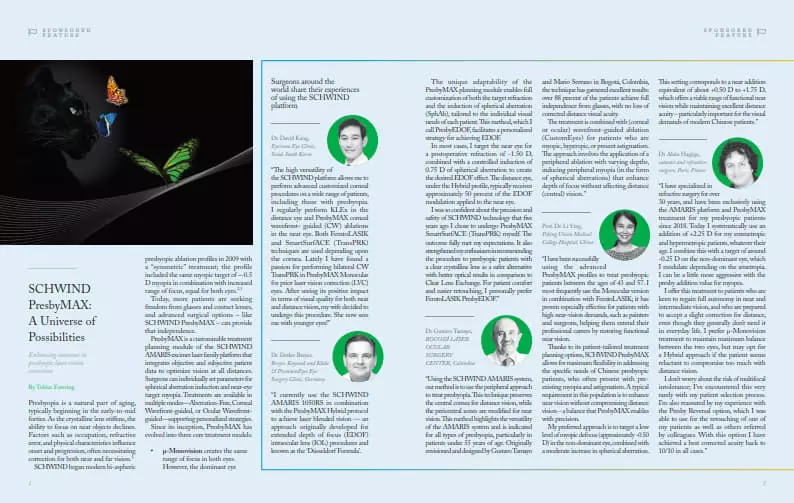By Tobias Ewering
Presbyopia is a natural part of aging, typically beginning in the early-to-mid forties. As the crystalline lens stiffens, the ability to focus on near objects declines. Factors such as occupation, refractive error, and physical characteristics influence onset and progression, often necessitating correction for both near and far vision.1
SCHWIND began modern bi-aspheric presbyopic ablation profiles in 2009 with a “symmetric” treatment; the profile included the same myopic target of ~-0.5 D myopia in combination with increased range of focus, equal for both eyes.2,3
Today, more patients are seeking freedom from glasses and contact lenses, and advanced surgical options – like SCHWIND PresbyMAX – can provide that independence.4
PresbyMAX is a customizable treatment planning module of the SCHWIND AMARIS excimer laser family platform that integrates objective and subjective patient data to optimize vision at all distances. Surgeons can individually set parameters for spherical aberration induction and near-eye target myopia. Treatments are available in multiple modes—Aberration-Free, Corneal Wavefront-guided, or Ocular Wavefront- guided—supporting personalized strategies. Since its inception, PresbyMAX has evolved into three core treatment models:
- µ-Monovision creates the same range of focus in both eyes. However, the dominant eye focuses slightly more towards far vision and the non-dominant eye more on near vision.
- Hybrid uses different intended range of focus values in the dominant and non-dominant eye to provide faster recovery of distance visual quality and good vision at all distances.
- Monocular does not alter the range of focus in the dominant eye. The non-dominant eye receives the same increased range of focus and target myopia as with the other proven PresbyMAX types. This approach offers the least compromise on distance vision while improving intermediate and near performance.
This flexibility allows the software to emulate alternative presbyopic approaches with excimer lasers, be they bi-lateral symmetric,5 µ-monovision,6 or even balanced vision concepts.7 Additionally, PresbyMAX includes a reversal function, enhancing safety and enabling approaches like peripheral presbyLASIK – placing near vision correction in the corneal periphery while preserving central distance vision.
PresbyMAX profiles are compatible with all AMARIS-supported laser techniques (FemtoLASIK, TransPRK (SmartSurfACE), etc.). Optical zone sizes are adaptable within software limits, often larger in surface than flap-based treatments, and typically require no manual refractive adjustments.
Peer-reviewed studies confirm the platform’s safety and long-term efficacy, even for patients with high refractive errors or irregular corneas.8-10 High satisfaction rates are linked to tailored aberration profiles and controlled induction of low myopia in the near eye. Notably, PresbyMAX Monocular has shown exceptional corrected distance visual acuity (CDVA) safety with no recorded reversals,11,12 while Hybrid protocols typically yield the best overall unaided vision.13 Postoperative contrast sensitivity and optical quality scores remain comparable to preoperative levels.10,13-15 Although PresbyMAX allows reversal of multifocality,16 its necessity and use is mostly anecdotal at this time.
Conclusion
SCHWIND offers fully personalized presbyopic treatments for patients’ unique visual needs. The short treatment times and optimized thermal control of the SCHWIND AMARIS excimer laser family reduces stress on the cornea and enhances safety.17,18 Moreover, the treatment is powered by up to 7D eye- tracking technology19 for improved precision during laser treatment.
References
- S Rather et al. “Decoding the Age of Presbyopic Revelation: An Investigation into Onset and Influencing Factors,” SSR-IIJLS, 11, 7001 (2025).
- Y Iribarne et al., “Bi-aspheric ablation profile for presbyopic hyperopic corneal treatments using AMARIS with PresbyMAX module: Multicen- tric Study in Spain,” Journal of Emmetropia, 3, 5 (2012).
- D Uthoff et al., “A new method of cornea modulation with excimer laser for simultaneous correction of presbyopia and ametropia,” Graefes Arch Clin Exp Ophthalmol., 250, 1649 (2012).
- “SCHWIND CAM, Perfect Planning – wide range of applications,” product brochure (2018).
- RE Ang et al., “Safety and effectiveness of the SUPRACOR presbyopic LASIK algorithm on hyperopic patients,” Eye Vis (Lond), 3:33 (2016).
- A Russo et al., “Visual and Refractive Outcomes Following Laser Blended Vision With Non-linear Aspheric Micro-anisometropia (PRESBYOND) in Myopic and Hyperopic Patients,” J Refract Surg., 38, 288 (2022).
- R Rahmania et al., “Clinical Effectiveness of Laser-Induced Increased Depth of Field for the Simultaneous Correction of Hyperopia and Presbyopia”, J Refract Surg., 37, 16 (2021).
- A Villanueva et al., “Long-term corneal multifocal stability following a presbyLASIK technique analysed by a light propagation algorithm”, Clin Exp Optom., 102, 496 (2019).
- MHA Luger, “Long-term Outcomes After LASIK Using a Hybrid Bi-aspheric Mi- cro-monovision Ablation Profile for Presbyopia Correction,” J Refract Surg., 36, 89 (2020). 1
- F Liu, “One year results of presbyLASIK using hybrid bi-aspheric micro-monovision ablation profile in correction of presbyopia and myopic astigmatism,” Int J Ophthalmol., 13, 271 (2020).
- S Ryu et al., “Presbyopia correction using the monocular bi-aspheric ablation profile in myopic eyes,” J Cataract Refract Surg., 49, 69 (2023).
- TC Chan et al., “Presbyopic Correction Using Monocular Bi-aspheric Ablation Profile (Presby- MAX) in Hyperopic Eyes: 1-Year Outcomes,” J Refract Surg., 33, 37 (2017).
- MH Luger et al., “Presbyopic LASIK using hybrid bi-aspheric micro-monovision ablation profile for presbyopic corneal treatments,” Am J Ophthalmol., 160, 493 (2015).
- D Fu et al., “Objective optical quality and visual outcomes after the PresbyMAX monocular ablation profile,” Int J Ophthalmol., 13, 1060 (2020).
- J Wierzbowska et al., “Contrast Sensitivity and Stereopsis Outcomes Following LASIK Presbyopia Correction Based on the Corneal Aberration Modulation or Corneal Multifocality Induction Methods: A Systematic Review,” J Clin Med., 14, 871 (2025).
- MH Luger et al., “Nonwavefront-guided Presby reversal treatment targeting a monofocal cornea after bi-aspheric ablation profile in a patient intolerant to multifocality,” J Refract Surg., 30, 214 (2014).
- MC Arbelaez, S Arba Mosquera, “The SCHWIND AMARIS Total-Tech Laser as An All-Rounder in Refractive Surgery,” Middle East Afr J Ophthalmol., 16, 46 (2009).
- AR Kee et al., “Outcomes of LASIK for Myopic Astigmatism Using a 1,050-Hz Excimer Laser and Seven-Dimensional Eye Tracker,” J Refract Surg., 41, e231 (2025).
- “Focus on performance, The SCHWIND AMARIS product family,” product brochure (2020).
This article is provided courtesy of The Ophthalmologist .
Source: The Ophthalmologist

